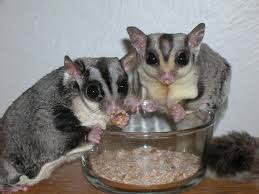The Sugar Glider is quickly becoming a very popular pet because of its sweet, lively, and inquisitive nature, but is illegal in certain states, such as California. Be sure to check your local and state laws before acquiring one.

Do sugar gliders make sounds? Yes, Sugar gliders are know to be very social creatures and make many different sounds, including barking, clicking, and chattering.
Are sugar gliders rodents? No. Sugar gliders are marsupials not rodents (mammals that carry their offspring in a pouch); they are in the same family as the kangaroo and the koala bear.
Sugar Gliders make excellent pets. They adapt very easily to captivity and develop very strong relationships with their human care takers. This is one reason they are great for people who are not able to have large pets. They are small in size, very intelligent and love to play. They are much smarter than a hamster or rat and have a longer life-span, most living to be 10 years of age or older if taken care of properly.
An adult sugar glider will grow to approximately 11 inches in length from his nose to the tip of his tail, but most of that (6 to 7 inches) is tail. They are very similar with the flying squirrel. The fur is very soft and is generally pearl grey, with black and cream patches at the base of the small pink ears. The tail tapers only moderately and the last quarter of it is normally black, often with a white tip. The muzzle is short and rounded. Northern forms tend to be brown colored rather than grey.
The most noticeable features of its anatomy, is the twin skin membranes called "patagiums" which extend from the fifth finger of the forelimb back to the first toe of the hind foot. These are hard to see when the Sugar Glider is at rest and merely look a little flabby, almost as if it had recently lost a lot of weight, but immediately obvious when it takes flight. The membranes are used to glide between trees or structures: when fully extended they form an aerodynamic surface the size of a large handkerchief.
Sugar Gliders can live in any area where there are tree hollows for shelter and sufficient food to eat. Their diet varies considerably with both geography and the changing seasons, but the main items are the sap of acacias and certain eucalyptus, nectar, pollen, and arthropods. They are difficult to see in the wild, being small, wary, and nocturnal, but a sure sign of their presence is the stripping of tree bark and tooth marks left in the soft, green shoots of acacia trees.
Sugar gliders love human attention and love to play. This is what makes them so special. Make sure you bond with the little ones when you bring them home. Since they sleep in the daytime, you can bond with them by letting them sleep in your pocket, but be careful not sit on your glider! Sugar gliders will often form very strong bonds with their owners.




